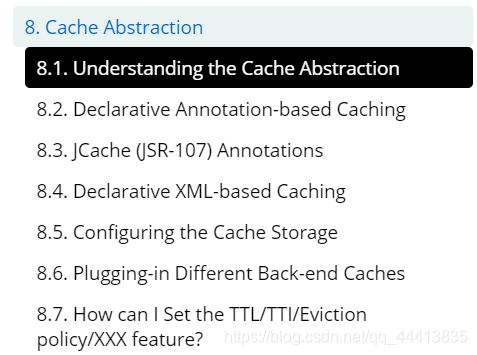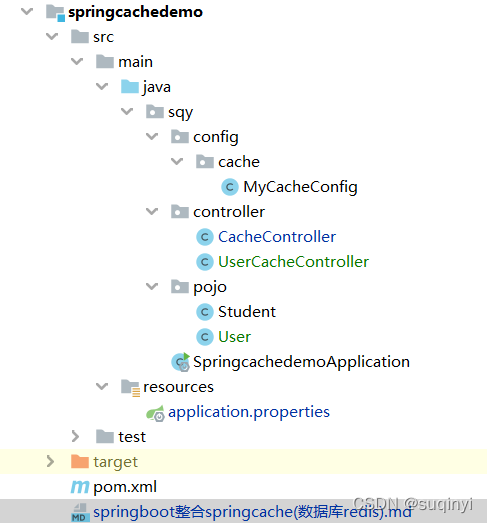系列文章目录
一、说明:
spEl语法说明==>官方文档
- Spring Cache是一项缓存
- 可以注解就达到缓存效果
- 小编的案例是基于springboot,整合是redis
官网springcache介绍目录:

官网的注解一共有5个,如图:

小编给他翻译下
| 注解 | 说明 |
|---|---|
| @Cacheable | 触发将数据保存到缓存的操作(启动缓存) |
| @CacheEvict | 触发将数据从缓存删除的操纵(失效模式) |
| @CachePut | 不影响方法执行更新缓存(双写模式) |
| @Caching: | 组合以上多个操作(点击注解看源码就知道了,组合注解) |
| @CacheConfig | 在类级别共享缓存的相同配置 |
概念图:

二、原理梳理
2.1、 比较重要的源码类
- CacheAutoConfiguration 缓存的自动配置
- 小编用的类型是redis所以看
RedisCacheConfiguration - CacheManager 缓存管理者
- 小编是类型是redis所以看
RedisCacheManager - CacheProperties 缓存默认配置
- idea搜索的方法 双击shift 或者 ctrl n
2.2、 原理说明:
流程说明:
CacheAutoConfiguration => RedisCacheConfiguration =>
自动配置了RedisCacheManager => 初始化所有的缓存 =>
每个缓存决定使用什么配置=>
=>如果RredisCacheConfiguration有就用已有的,没有就用默认配置(CacheProperties)
=>想改缓存的配置,只要给容器中放一个RredisCacheConfiguration即可
=>就会应用到当前RedisCacheManager管理的所有缓存分区中
三、默认缓存的数据类型
在默认配置下,springcache给我们缓存的试用jdk序列化过的数据
我们通常是缓存Json字符串,因为使用Json能跨语言,跨平台进行交互
所以我们要修改他的默认配置,包括ttl(过期时间)、存储格式、等…
四、整合
项目结构:

4.1、引入依赖
<!--spring-boot-starter-data-redis-->
<dependency>
<groupId>org.springframework.boot</groupId>
<artifactId>spring-boot-starter-data-redis</artifactId>
</dependency>
<!--spring cache-->
<dependency>
<groupId>org.springframework.boot</groupId>
<artifactId>spring-boot-starter-cache</artifactId>
</dependency>
4.2、先看下配置源码是怎么样的
RedisCacheConfiguration

4.3、创建配置类(照猫画虎)
注意事项:要让原本配置文件的一些配置生效
开启属性绑定配置的功能
@EnableConfigurationProperties(CacheProperties.class)
MyCacheConfig
package sqy.config.cache;
import org.springframework.boot.autoconfigure.cache.CacheProperties;
import org.springframework.boot.context.properties.EnableConfigurationProperties;
import org.springframework.cache.annotation.EnableCaching;
import org.springframework.context.annotation.Bean;
import org.springframework.context.annotation.Configuration;
import org.springframework.data.redis.cache.RedisCacheConfiguration;
import org.springframework.data.redis.serializer.GenericJackson2JsonRedisSerializer;
import org.springframework.data.redis.serializer.RedisSerializationContext;
import org.springframework.data.redis.serializer.StringRedisSerializer;
/**
* @author suqinyi
* @Date 2022/1/13 -更新
*/
@EnableConfigurationProperties(CacheProperties.class)//开启属性绑定配置的功能
@Configuration //配置类
@EnableCaching //开启缓存功能
public class MyCacheConfig {
// 第一种、从容器里面拿
// @Autowired
// CacheProperties cacheProperties;
/**
* 配置文件中的很多东西没用上
* 1、原来和配置文件绑定的配置类是这个样子的
* @ConfigurationProperties(
* prefix = "spring.cache"
* )
* public class CacheProperties
*
* 2、要让他生效
* @EnableConfigurationProperties(CacheProperties.class)//开启属性绑定配置的功能
*
*/
//第二种、因为注入了容器,参数属性spring会自己去容器里面找 (CacheProperties cacheProperties)
@Bean
RedisCacheConfiguration redisCacheConfiguration(CacheProperties cacheProperties){
RedisCacheConfiguration config = RedisCacheConfiguration.defaultCacheConfig();
// config=config.entryTtl();
config= config.serializeKeysWith(RedisSerializationContext.SerializationPair.fromSerializer(new StringRedisSerializer()));
/**
* GenericFastJsonRedisSerializer fastjson家族的
* GenericJackson2JsonRedisSerializer spring自带的 package org.springframework.data.redis.serializer;
*/
//指定序列化-Jackson
config = config.serializeValuesWith(RedisSerializationContext.SerializationPair.fromSerializer(new GenericJackson2JsonRedisSerializer()));
//指定序列化-fastjson
//config= config.serializeValuesWith(RedisSerializationContext.SerializationPair.fromSerializer(new GenericFastJsonRedisSerializer()));
//从所以配置中取出redis的配置
CacheProperties.Redis redisProperties = cacheProperties.getRedis();
//将配置文件中所有的配置都生效(之间从源码里面拷 RedisCacheConfiguration)
if (redisProperties.getTimeToLive() != null) {
config = config.entryTtl(redisProperties.getTimeToLive());
}
if (redisProperties.getKeyPrefix() != null) {
config = config.prefixKeysWith(redisProperties.getKeyPrefix());
}
if (!redisProperties.isCacheNullValues()) {
config = config.disableCachingNullValues();
}
if (!redisProperties.isUseKeyPrefix()) {
config = config.disableKeyPrefix();
}
return config;
}
}
4.4、配置文件(application.properties)
#类型指定redis
spring.cache.type=redis
#一个小时,以毫秒为单位
spring.cache.redis.time-to-live=3600000
#给缓存的建都起一个前缀。 如果指定了前缀就用我们指定的,如果没有就默认使用缓存的名字作为前缀,一般不指定
#spring.cache.redis.key-prefix=CACHE_
#指定是否使用前缀
spring.cache.redis.use-key-prefix=true
#是否缓存空值,防止缓存穿透
spring.cache.redis.cache-null-values=true
4.5、使用
在方法上标注注解就可以
4.5.1、@Cacheable(开启缓存功能)
将查询到的结果存入缓存
注意事项
- 有对应的缓存就不进入方法 [需要返回值,没有返回值缓存空值]
- @Cacheable并没有单独的失效时间的方法。
- 但是可以在CacheManager配置,在+上自动刷新的功能,但是这样的的操作比较繁琐。如果不设置,只有统一的过期时间很容易导致缓存雪崩的问题
01、有返回缓存
/**
* TODO @Cacheable并没有单独的失效时间的方法。
* 但是可以在CacheManager配置,在+上自动刷新的功能,但是这样的的操作比较繁琐。
* 如果不设置,只有统一的过期时间很容易导致缓存雪崩的问题。
*
* @Cacheable开启缓存功能 有对应的缓存就不进入方法 [需要返回值,没有返回值缓存空值]
* value = "student", 【key ="#root.methodName" 或 key = "'名称'" 或 key = "#传入的参数" 或 key = "#接收参数的实体.属性"
* 更多方式看spEl语法 】
* <p>
* student是分区名字
* #root.methodName是spEl语法 也就是方法名 testCache
* <p>
* 在redis里面 他的存储就是 student::testCache
* 同一个业务类型是数据放在同一个分区,树形结构,
* 类如:a包里面有b,c。 b和c就是具体缓存。a就是名称空间
* @Cacheable(value = {"student"},key ="#root.method.name" ,sync = true)
* sync = true 这个属性的意思是加锁,解决缓存击穿问题
*/
//localhost:8080/testCache
@Cacheable(value = "student", key = "#root.method.name")
@GetMapping("/saveCache01")
public HashMap<String, List<Student>> saveCache01() {
System.out.println("方法saveCache01执行");
HashMap<String, List<Student>> map = new HashMap<String, List<Student>>();
List<Student> studentList = new ArrayList<>();
studentList.add(new Student("ssm", "888888"));
studentList.add(new Student("boot", "123456"));
studentList.add(new Student("cloud", "741147"));
map.put("studentList", studentList);
System.out.println("缓存成功");
return map;
}
02、无返回值,或者返回空,缓存空值
/**
* 1、返回值为void 缓存空值
* 2、返回null 缓存空值
* TODO 【NullValue】
* sr+org.springframework.cache . support.NullValue xp
*/
@Cacheable(value = "student", key = "#root.method.name")
@GetMapping("/saveCache02")
public void saveCache02() {
System.out.println("方法saveCache02执行");
HashMap<String, List<Student>> map = new HashMap<String, List<Student>>();
List<Student> studentList = new ArrayList<>();
studentList.add(new Student("ssm", "888888"));
studentList.add(new Student("boot", "123456"));
studentList.add(new Student("cloud", "741147"));
map.put("studentList", studentList);
System.out.println("缓存成功");
}
4.5.2、@CacheEvict(失效模式)
简单的说:就是你执行了修改/删除的操作,他会将缓存里面数据给清除
第一种、删除单个
/**
* 失效模式(可以叫删除模式)
* value = "student",key = "'saveCache01'" 注意单引号
* student是分区名字
* saveCache01是缓存的key值。使用@Cacheable缓存的时候spEl我们指定的方法名
* todo @CacheEvict(value = "student",allEntries = true) allEntries = true表示删除student分区下所有数据
*/
@CacheEvict(value = "student", key = "'saveCache01'")//缓存 失效模式
@GetMapping("/updateData")
public void updateData() {
System.out.println("执行失效模式,删除缓存");
}
第二种、删除多个,将整个分区的缓存都清除
好比说 a下面有b和c 。将b和c一起删除
所以:同一业务\同一类型缓存的数据要放在同一的分区下面
//1、失效模式
//2、allEntries = true 删除分区所有的数据
@CacheEvict(value = "category",allEntries = true)
@Transactional
@Override
public void updateCascade(CategoryEntity category) {
//service的业务代码
}
4.5.3、@Caching(组合使用)
源码:

比如说要让哪个分区下面的哪个缓存失效(删除)
/**
* TODO @Caching 组合注解 允许在同一方法上使用多个嵌套的 @Cacheable、@CachePut和@CacheEvict
* value ==> student分区
* key ==> saveCache01 缓存的key名称
* 个人感觉还是使用@CacheEvict的删除分区里面全部的缓存方便点
*/
@Caching(evict = {
@CacheEvict(value = "student", key = "'saveCache01'"),
@CacheEvict(value = "student", key = "'saveCache02'")
})
@GetMapping("/selectEvict")
public void selectEvict() {
System.out.println("组合注解=>指定分区下失效的key");
}
4.5.4、@CachePut(双写模式)
/**
* @CachePut
* 根据返回值更新缓存,【双写模式】,用得比较少,这边就不搞了
*/
@CachePut
@GetMapping("/testPut")
public void testPut() {
System.out.println("双写模式");
}
4.5.5、redisTemplate获取数据方法
- 这边使用的是StringRedisTemplate
- 没使用RedisTemplate因为没去重构序列化器
@Autowired
StringRedisTemplate redisTemplate;//采用string的序列化构造器
@GetMapping("/getCache")
public void getCache() {
HashMap<String, List<Student>> map = new HashMap<String, List<Student>>();
List<Student> studentList = new ArrayList<>();
studentList.add(new Student("ssm", "888888"));
studentList.add(new Student("boot", "123456"));
studentList.add(new Student("cloud", "741147"));
map.put("studentList", studentList);
redisTemplate.opsForValue().set("student::saveCache03", String.valueOf(map));
System.out.println("获取缓存");
String s = redisTemplate.opsForValue().get("student::saveCache03");
System.out.println(s);
}
4.5.6、测试效果
01、

02、

03、

04、

五、简单实战案例
实体类:
package sqy.pojo;
import org.springframework.stereotype.Component;
/**
* @author suqinyi
* @Date 2022/1/21
* user表
*/
//@Component
public class User {
private String id;//主键
private String userName;//用户名
private String password;//密码
//get /set /构造、tostring...省略
}
实战测试:
package sqy.controller;
import org.springframework.cache.annotation.*;
import org.springframework.web.bind.annotation.PostMapping;
import org.springframework.web.bind.annotation.RequestBody;
import org.springframework.web.bind.annotation.RestController;
import sqy.pojo.User;
import java.io.IOException;
/**
* @author suqinyi
* @Date 2022/1/21
* springCache的实战使用【sqy测】--- TODO 缓存数据不要去数据库直接改数据!!!
*/
@RestController
@CacheConfig(cacheNames = "user")//指定缓存空间的名称
//@Lazy//懒加载--这个有毒测试着玩,用于注入的service
public class UserCacheController {
/**
* todo 说明
*
* @Cacheable 必须要有返回【实体、list、map】-- 用于 查询
* @CachePut 必须要有返回【实体、list、map】-- 用于 新增、修改
* @CacheEvict 返回值为void--用于 删除
* @CacheConfig 配置 --通常用于指定缓存空间名称较多
* @Cacheable 组合注解 [ cacheable() 、put()、evict() ] 存、加、删
*/
// private static List<User> list = new ArrayList<>();
//模拟从数据库获取到数据
private User getUserData01() {
User user = new User("001", "userOO1", "123456");
return user;
}
//模拟从数据库获取到数据
private User getUserData02() {
User user = new User("002", "userOO2", "789456");
return user;
}
/**
* 主键查询--这个缓存是在service做,测试案例我就之间在controller写了
* 名称空间value 在controller统一指定了
* 缓存key为 名称空间::id
*
* @Cacheable(key = "#qvo.id",unless = "#result!=null" )
* unless = "#result!=null" 返回的结果不为空才缓存
* 这个方法不缓存空值
* localhost:8080/findById
* post json {"id":"1"}
*/
@PostMapping("/findById")
@Cacheable(key = "#qvo.id")
public User findById(@RequestBody User qvo) {
System.out.println("执行方法-findById");
//查到数据
if ("001".equals(qvo.getId())) {
User user = getUserData01();
return user;
} else {
return null;
}
}
/**
* 用户名查询
* 名称空间value 在controller统一指定了
* 缓存key为 名称空间::id
* 这个查询缓存空值 sr+org.springframework.cache . support.NullValue xp
* localhost:8080/findByName
* post json {"userName":"userOO1"}
*/
@PostMapping("/findByName")
@Cacheable(key = "#qvo.userName")
public User findByName(@RequestBody User qvo) {
System.out.println("执行方法-findByName");
//查到数据
if ("userOO1".equals(qvo.getUserName())) {
User user = getUserData01();
return user;
} else {
return null;
}
}
/**
* 新增数据-测试 @Caching组合注解
* 缓存新增的id和用户名
* condition = "#result != null" 当结果不为空时缓存
* localhost:8080/userSave
* post json {"id":"002","userName":"user002"}
*/
@PostMapping("/userSave")
@Caching(put = {
@CachePut(key = "#result.id", condition = "#result != null"),
@CachePut(key = "#result.userName", condition = "#result != null")
})
public User userSave(@RequestBody User vo) throws IOException {
if ("002".equals(vo.getId()) && "user002".equals(vo.getUserName())) {
//1、存入数据库 2、查询数据返回
System.out.println(vo);
return vo;
} else {
return null;
}
}
/**
* 修改数据-测试 @Caching组合注解---
* 【有双写模式@CachePut 和 失效模式@CacheEvict 】
* 缓存新增的id和用户名
* condition = "#result != null" 当结果不为空时缓存
*
* localhost:8080/userUpdate
* post json {"id":"002","userName":"user003"}
*/
@PostMapping("/userUpdate")
@Caching(put = {
@CachePut(key = "#result.id", condition = "#result != null"),
@CachePut(key = "#result.userName", condition = "#result != null")
})
public User userUpdate(@RequestBody User vo) {
//将原本2号数据user002改成user003
if ("002".equals(vo.getId()) && "user003".equals(vo.getUserName())) {
//查数据
User user = getUserData02();
//更新
user.setUserName(vo.getUserName());
user.setPassword(vo.getPassword());
return user;
} else {
return null;
}
}
/**
* 删除数据
* 缓存新增的id和用户名
* condition = "#result != null" 当结果不为空时缓存
* localhost:8080/userDel
* post json {"id":"001","userName":"user001"}
*
*/
@PostMapping("/userDel")
@Caching(evict = {
@CacheEvict(key = "#vo.id"),
@CacheEvict(key = "#vo.userName")
})
public void userDel(@RequestBody User vo) throws Exception {
//删除1号数据
if ("001".equals(vo.getId()) && "user001".equals(vo.getUserName())) {
//1、查数据
User user = getUserData01();
System.out.println(user);
//2、删除 ...
} else {
throw new Exception("id不是1,不能删");
}
}
/**
* 查询-有缓存就查缓存,不走方法
* localhost:8080/findUser
* post josn {"id":"001","userName":"user001"}
*/
@PostMapping("/findUser")
public void findUser(@RequestBody User vo) throws Exception {
if ("001".equals(vo.getId())) {
User user = this.findById(vo);
System.out.println("findById==>" + user);
}
if ("user001".equals(vo.getUserName())) {
User user = this.findByName(vo);
System.out.println("findByName==>" + user);
}
}
}
效果:

六、小归纳
@Cacheable
代表当前方法的结果需要缓存
如果缓存种有,方法不用调用
如果缓存中没有,就会调用方法,将方法的结果放入缓存
@Cacheable(value = {"category"})
每一个需要缓存的数据都来指定要放到那个名字缓存。[缓存的分区(推荐按照业务类型划分)]
默认行为
1、缓存中有,方法不用调用
2、key默认生成,缓存的名字::SimpleKey [](自主生成的key值)
3、缓存value的值,默认采用jdk序列化机制,将序列化后的数据存到redis
4、默认的ttl时间是 -1 代表永不过期
自定义操作:
1)、指定生成的缓存使用的key: 使用key属性指定,接收一个spEl表达式
spEl语法说明==>官方表达式地址说明:https://docs.spring.io/spring-framework/docs/current/reference/html/integration.html#cache-spel-context
2)、指定缓存的数据的存活时间: 在配置文件中修改ttl
3)、将数据保存为json (因为json跨平台跨语言能交互)
源码类
CacheAutoConfiguration
RedisCacheConfiguration
七 、Spring-Cache的不足:
SpringCache对读模式都进行处理,解决了缓存击穿,缓存穿透,缓存雪崩的问题
但是对写模式并没有去处理
读模式(SpringCache都处理了)
- 缓存穿透:查询一个null数据。
解决方法:缓存空数据。 spring.cache.redis.use-key-prefix=true - 缓存击穿:大量并发进来,查询一个正好过期的数据。
解决方法:加锁 :默认是无加锁的; sync = true(加锁,解决缓存击穿) - 缓存雪崩:大量的key同时过期
解决方法:加随机时间 (很容易弄巧成拙,要注意) spring.cache.redis.time-to-live=3600000
写模式(SpringCache没有管)
我们该如何解决(3种方式)
- 读写加锁
- 引入中间件Canal,感知到mysql的更新去更新
- 读多写多的,直接去数据库查询
八、个人推荐:
- 如果集成最后要配置缓存管理。
要加锁、加自动过期等配置 - 当然还有其他选择如:
redis、
redisson 分布式、
caffeine 这个会增大服务器压力、
Guava 是Google Fuava中的一个内存缓存模块、
Ehcache 是一个Java实现的开源分布式缓存框、
JBoss Cache 分布式
…
九、小结:
常规数据:(读多写少,即使性、一致性要求不高的的数据)
完成可以使用spring-cache,写模式(是要缓存的数据有过期时间就足够了)
特殊数据: 特殊设计






















 354
354











 被折叠的 条评论
为什么被折叠?
被折叠的 条评论
为什么被折叠?










